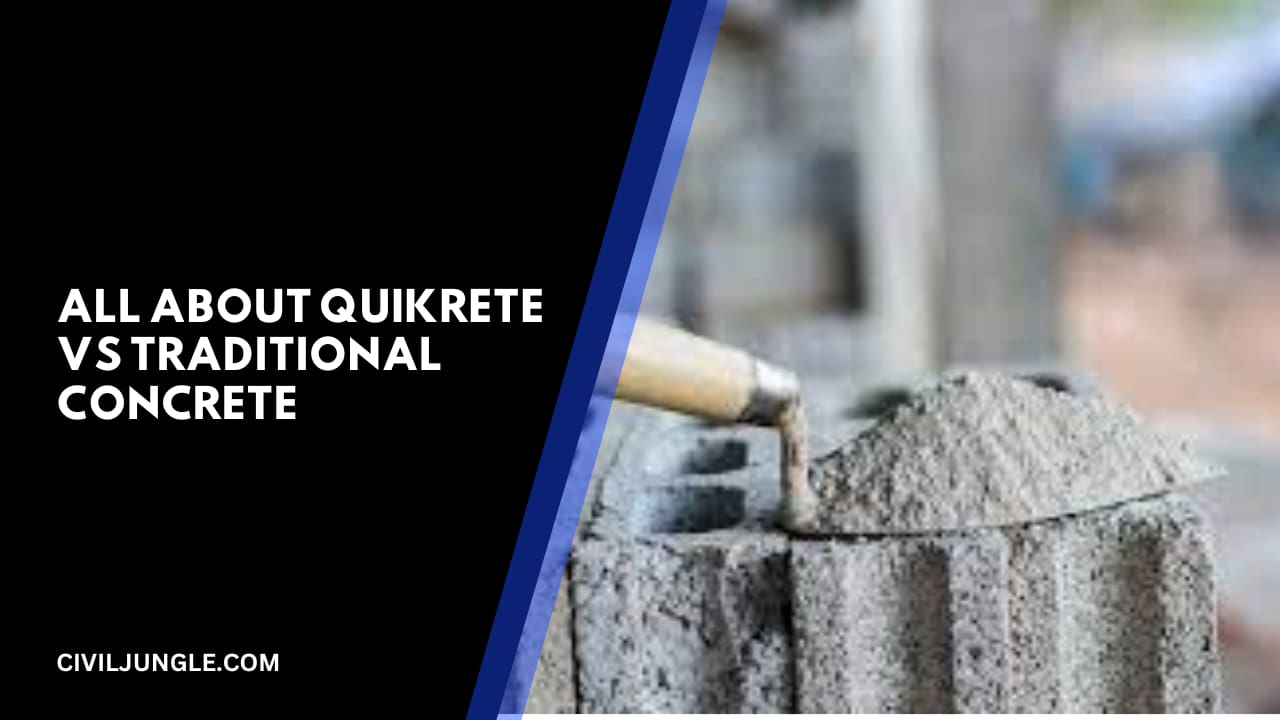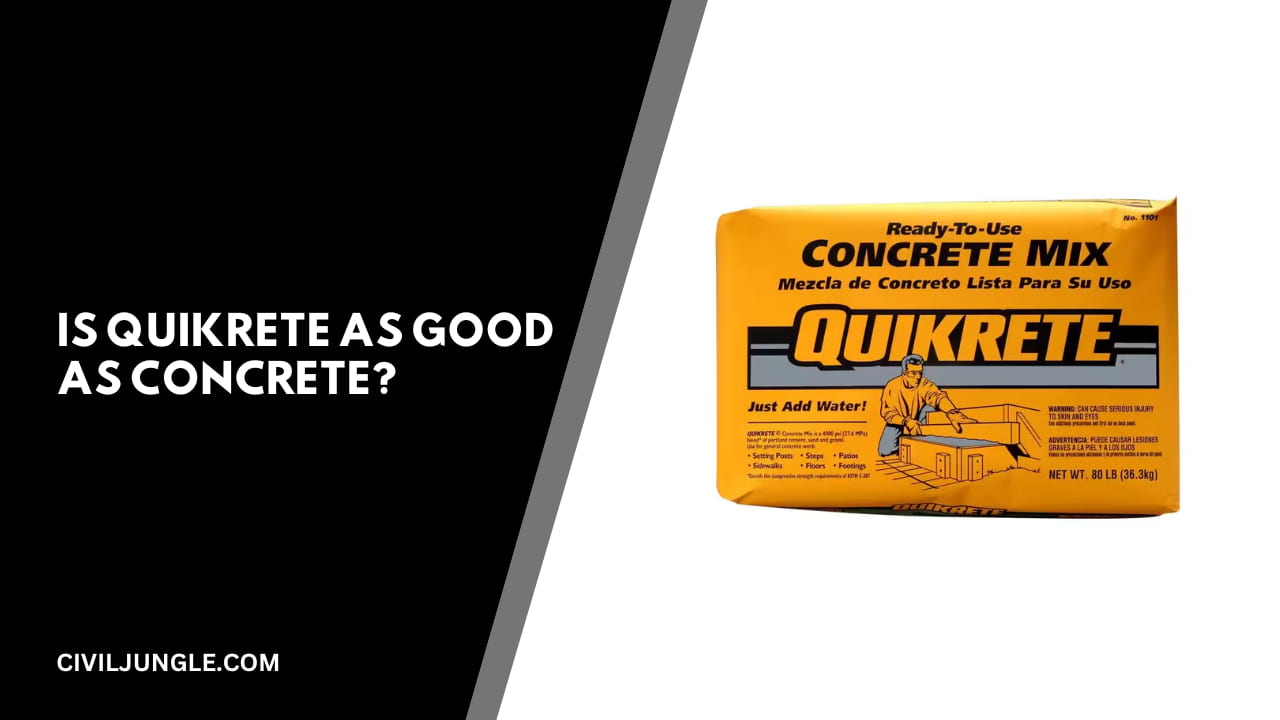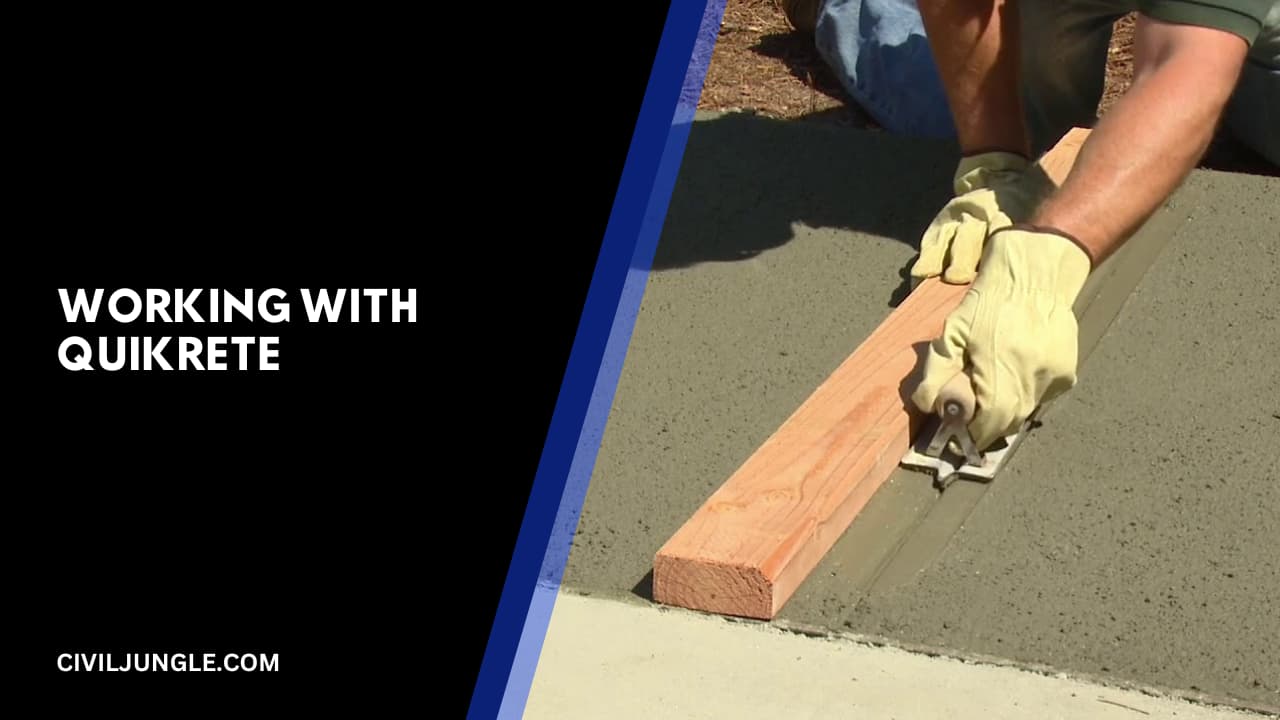Is Quikrete as Good as Concrete?
Important Point
Pre-mixed concrete from Quikrete is just as robust and reliable as conventional plant-bought or on-site-mixed concrete. Quikrete concrete is comprised of the same materials as regular concrete: sand, cement, and aggregate.
Pre-mixed sachets are really simple to use because all the ingredients were previously combined at the right rate for the strength you require. You may use Quikrete right out of the bag to make almost anything because the bags are available in a variety of strengths up to 5000 psi.
And much as conventional concrete, you can add other components to Quikrete if you require an unique commodity, like underpinning or color. Quikrete provides a variety of composites for use in various applications.
Traditional composites with vibrant strengths and properties like quick setting and crack resistance are among them. They do provide composites for specialized tasks, such as worktops or structural shower servers. Quick Set is one of the most utilized Quikrete mixtures.
It is far stronger than regular concrete and hardens much faster. However, if you are working on a job that requires a quick turnaround time, like putting hedge posts, you will appreciate having concrete that hardens quickly. Concrete made with Quikrete has the same strength as normal concrete.
Concrete’s strength is provided by a chemical reaction that occurs during the curing process. Quikrete can achieve strengths of exceeding 20,000 psi after curing, which typically takes 28 days. But why not apply it to everything?
If the pre-mixed, quick-setting concrete from Quikrete is every bit as durable and reliable as regular concrete. The price differential between Quikrete and normal concrete is the highest. Quikrete is quite convenient because it comes pre-mixed and packaged. But in terms of cost, it is in the middle. Making your own concrete is the most affordable option.
The issue is that you have to figure out all the prices on your own and that all the redundant work is expensive. Cement and aggregate conditions, however, are correct. If the beach is not obtained.
Concrete exchanges are excellent for large projects because they allow you to precisely direct tons of concrete, but they are expensive. In particular for light loads. swiftly set Quikrete contains specific materials that make it more opulent than the ordinary batch.
Because it sets so rapidly, you’ll have to pay a little more. However, if you only need one bag, the price difference might only be a few dollars. However, those extra expenditures can pile up if you are mixing 100 bags. Depending on what you’re using it for will determine whether Quikrete is superior to regular concrete.
It makes even more sense for some systems to purchase concrete by truckload. If you’re pouring a sizable sundeck arbor, however, it takes too long and adds a lot of effort to also mix your own concrete by hand and drive it into place.
Investing in a vehicle pays off because you may avoid paying for new labor. However, Quikrete quick-setting concrete is the best option if you’re installing numerous hedge posts.
Quikrete Vs Traditional Concrete:
Swiftly set Pre-mixed concrete costs a little extra, but for some systems it’s worth it. mostly for tiny enterprises or time-sensitive businesses. Whenever utilizing conventional concrete requires extreme labor or takes longer than two hours, I generally try to use quick setting premixes. Compared to that, normal concrete requires 8 hours to dry.
The extra $1–$2 per bag is undoubtedly worth it because it saves you time. Concrete that sets quickly works best with lower systems that do not support a trowel. But avoid using it for substantial crossbeams.
Concrete hardens very quickly, therefore using a rapid trowel to smooth it out may not be appropriate. Some concrete systems work better with normal concrete that dries more slowly. Another issue is the weather.
Use Quikrete, though, if you want to avoid heavy rain and must leave. Using quickly curing concrete undoubtedly has benefits. Large systems, tasks requiring a trowel, and projects that don’t require immediate completion can be completed with regular concrete. Normal concrete is typically used to pour whole sidewalks.
Even so, I use Quikrete for simpler tasks. In warm showers, regular concrete is also acceptable. Whatever its type, concrete typically settles quickly when heated. However, you must work incredibly quickly.
If you have hot weather and quick-setting concrete, such as Quikrete. Otherwise, there is a risk that the concrete would harden too quickly. In general, it looks good when dealing with concrete to stay out of excessive heat and cold.
Setting the time When compared to the conventional concrete blend, time is everything. This is due to Quikrete being regular concrete in all other felicitations. The incipiency time is the only distinction. Quikrete typically dries in 25 to 40 twinkles. Ordinarily, it takes many hours to mix concrete.
It is a significant difference. Additionally, each has benefits and drawbacks. Which bone is superior mostly depends on the circumstances. For modest jobs that benefit from a combination of quick setup, I use Quikrete. Minor fixes, sundeck foundation work, installing hedge posts, etc. Before I can finish other effects, I do not want to lose time waiting for the concrete to harden.
But using quick-setting concrete is impossible when creating a sizable yard arbor. To spread and smooth the concrete, you need time. Create homestretches, smooth and shape shells, mix hues, spread trowel edges, and acclimatize stamped shapes.
Because the completed concrete requires more time to work, quick-set concrete is not advised. Utilizing bagged premixes has both benefits and drawbacks. Mixing 100-pound bags of 80 is a hassle for big operations.
The importance of carrying these bags is equal to that of mixing. Then, you might wish to purchase a truck or mix the concrete yourself. Quikrete bags, however, may be preferable for small to medium-sized organizations. Particularly when the concrete needs to quickly set.
Why Does Quikrete Set Up So Fast?
The reaction between cement and water chemically gives concrete its strength. This action is referred to as “mending”. Concrete does not set or solidify throughout the curing process. As an example, while a concrete yard is often installed and operational in one day, concrete might take up to 28 days to fully cure and reach its optimum strength.
Quikrete uses various secret complements that are not disclosed on the marking, and its component rates are slightly different from those of conventional concrete. This quickens the reaction, which causes the concrete to solidify more quickly.
However, it takes roughly a month for the repairs to be finished. Exothermic response is the term used to describe the reaction. That implies that the heat is a result of a chemical reaction. For all concrete, this is accurate.
Have you ever observed that once it hardens, concrete can get warm? There is an internal repair process taking place. Regular concrete can be enhanced with components to set just as quickly as Quikrete.
Rewind: Regular concrete and Quikrete are essentially the same. The only ingredients are gravel, cement, and water. Altering this rate and adding new ingredients causes Quikrete to set substantially more quickly while maintaining its stability.
Also Read: All About Concrete Bond | Will Concrete Bond to Concrete | How Concrete Adhesion Works
Working with Quikrete:
In almost every road, quick-drying concrete is essentially identical to regular concrete. This is so because their constituents are essentially the same Fast-setting concrete. Both are primarily made of cement, a beach, and entire. The sole distinction is that Quikrete has a few complements that act quickly and a little different pace. But it is still obvious.
Working with Quikrete is similar to working with ordinary concrete. Pour, mix, and kerchief all at once. The speed differential is the only distinction. If you work with conventional concrete, however, moving to Quikrete will be the outcome.
Concrete forming and sweeping won’t require the same amount of time. Because of this, I advise using Quikrete for simple projects or untreated systems. It’s easy to quickly personalize Quikrete on shoes.
Regular concrete is preferable for precast pavements with edges and a flush finish, nevertheless. Nevertheless, if you intend to utilize fast-setting concrete, be ready to move quickly. There is little you can do to shape or smooth the concrete once it has hardened. The difference in fixed speed aside, it is the same as regular concrete.
Is Quikrete as Good as Concrete?
Quikrete, or rapid-set concrete, is just as strong as regular concrete and able to withstand similar force. Quikrete offers different PSI strength ratings from 4,000 PSI to 6500 PSI. Regular concrete PSI ranges from 2,500 to 5,000 except for engineered concrete strength which can be up to 10,000 PSI.
Quikrete Vs Concrete Cost
Although Quikrete is more expensive than traditional concrete, it is much cheaper to install in comparison. In fact, the average installation cost for a Quikrete installation is around $1,000 whereas the same job for Traditional Concrete can cost over $2,000.
Can You Use Quikrete for a Driveway?
Use QUIKRETE® Concrete Resurfacer for residential or commercial applications including: Sidewalks. Driveways. Floors.
Can You Use Quikrete for a Slab?
Concrete is one of the most economical, versatile and durable building materials available. Build a sidewalk, patio, or floor with QUIKRETE concrete mixes no matter your skill level. If playback doesn’t begin shortly, try restarting your device.
How Thick Can You Pour Quikrete?
Concrete Repair can be applied up to about 3/8″ thick.
Concrete Vs Cement
What is the difference between cement and concrete? Although the terms cement and concrete often are used interchangeably, cement is actually an ingredient of concrete. Concrete is a mixture of aggregates and paste. The aggregates are sand and gravel or crushed stone; the paste is water and portland cement.
Also Read: Steel Is Stronger Than Concrete
Ready Mix Vs Site Mix Concrete Cost
The cost required for 1 cubic meter concrete made with RMC is approximately need 4000 to 4400 Indian rupees and vehicle charge (material transport) is extra. For making the 1 cubic meter concrete in site mix it requires approximately need 3800 to 4200 Indian rupees.
Mixing Your Own Concrete Vs Buying
Mixing your own concrete can be cheaper if you have access to the necessary equipment and materials, and if you are able to mix the concrete in bulk. However, if you only need a small amount of concrete or if you do not have the equipment and resources to mix it yourself, it may be cheaper to have it delivered.
How Much Water to Mix with 60 Lb Bag of Quikrete?
Pour water into the dry mix until the powder is saturated with water. Depending on soil conditions, this will require about 1-1/4 gallon (4.7 L) of water per 60 lb (27.2 kg) bag.
Quikrete Concrete Mix Water Ratio
QUIKRETE Concrete Mix may also be mixed by hand. Empty concrete bags into a suitable mixing container. For each 80 lb (36.2 kg) bag of mix, add approximately 6 pt (2.8 L) of clean water. Work the mix with a shovel, rake or hoe and add water as needed until a stiff, moldable consistency is achieved.
How to Mix Concrete in a Bucket?
How to do it: Dump the required amount of bagged mix into the bucket, form a depression in the middle of the mix, and then slowly add about three-quarters of the amount of water called for per the package directions. (If you don’t need to use the entire bag, remember to adjust the amount of water accordingly.)
How to Mix Quikrete 50 L?
Pour water into the dry mix until the powder is saturated with water. Depending on soil conditions, this will require about 1 gallon (3.8 L) of water per 50 lb (22.7 kg) bag. For holes deeper than 2′ 6″ (0.8 m), place the material in lifts of 2′ 6″ (0.8 m) or less to allow water to soak all the way through.
What Happens If You Add Too Much Water to Quikrete?
NOTE: the more water that is added to the mix the weaker it becomes; adding one extra quart of water per 80 lb bag can reduce the strength of the concrete by up to 40%.
Will Quikrete Harden Underwater?
If you have a pool, fountain or retaining wall, QUIKRETE Hydraulic WaterStop Cement is helpful to keep on hand. This material sets quickly, even when completely submerged underwater in a pool or fountain.
What Happens If You Put Too Much Water in Concrete Mix?
Lower compressive strengths. Segregation of the concrete mix under certain conditions resulting in variable quality throughout the concrete mass. Cracking – with too much water, there will be lower tensile strength, and a tendency towards high shrinkage and subsequent cracking.
How Many Bags of Quikrete Do I Need for a Yard of Concrete?
bag of Quikrete Concrete Mix will yield approximately . 60 cu. ft. So it will take 45 bag to equal one cubic yard of concrete.
Like this post? Share it with your friends!
Suggested Read –
- bitumen vs tar
- Quikrete Dry Pack
- Different Concrete Finishes
- Stepped Footing | House Foundation on Slope | How to Build a Foundation on the Slope
- What Is a Residential Building | Types of Residential Buildings | Site Selection for Residential Buildings
- What Are Curb and Gutter | Types of Curb and Gutter| Advantages & Disadvantages of Curb and Gutter
- All About Hairline Crack In Concrete | What Causes Hairline Cracks In Concrete | How To Prevent Hairline Cracks In Concrete
- What Is Pier and Beam Foundation | Advantages & Disadvantage of Pier and Beam Foundations | Pier and Beam Foundation Design | How to Build a Post and Pier Foundation






Leave a Reply